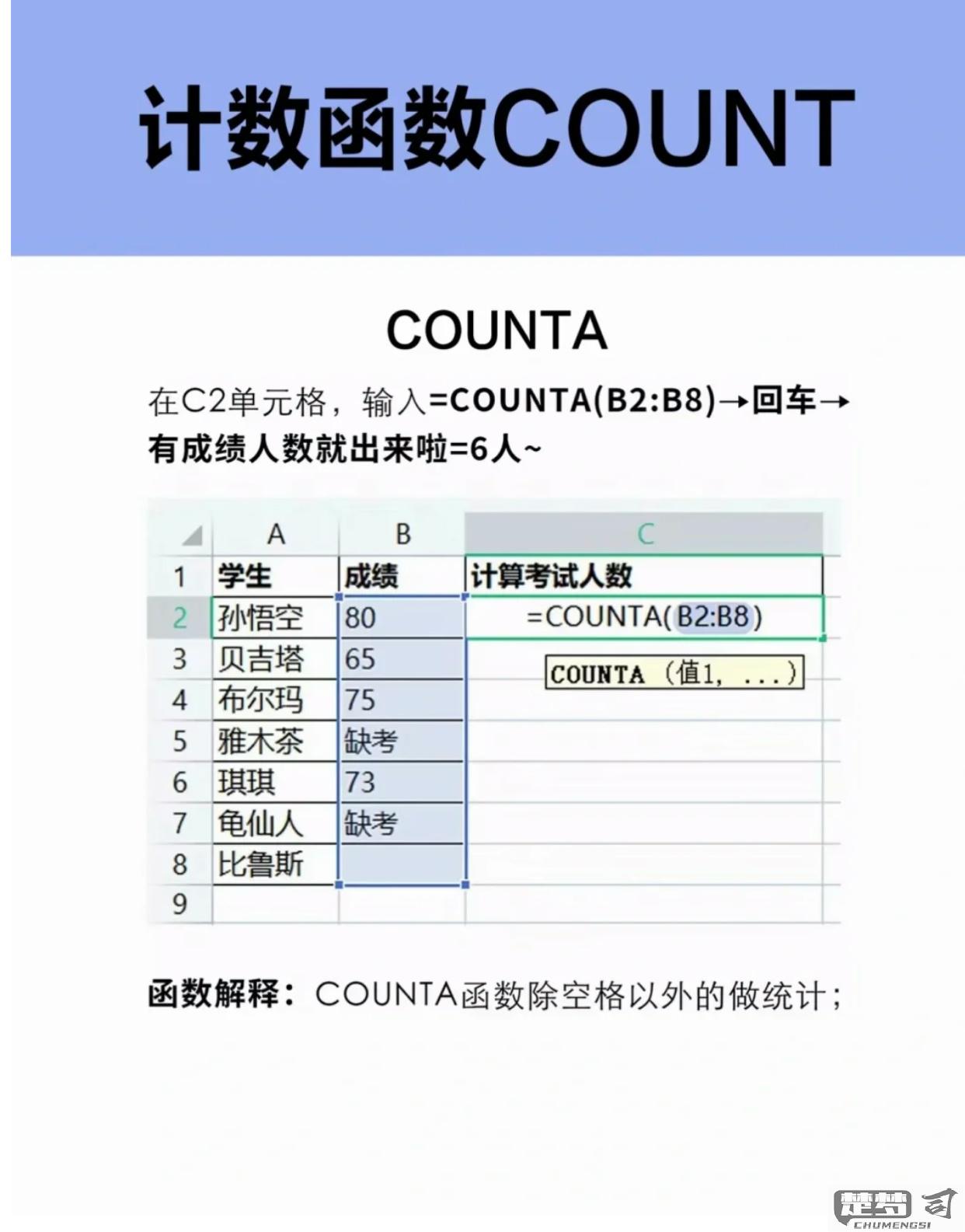count函数怎么用
count函数在不同编程语言和工具中有不同用法,以下是常见场景下的详细说明:
SQL中的count函数:
`sql
-- 统计表中所有记录数(包括NULL值)
SELECT COUNT(*) FROM table_name;
-- 统计特定列非NULL值的数量 SELECT COUNT(column_name) FROM table_name;
-- 配合DISTINCT统计唯一值数量
SELECT COUNT(DISTINCT column_name) FROM table_name;
`
Python中的count方法:
`python
fruits = ['apple', 'banana', 'apple', 'orange'] print(fruits.count('apple')) # 输出2
text = "hello world hello"
print(text.count('hello')) # 输出2
`
Excel中的COUNT函数:
=COUNT(A1:A10) 统计数值单元格数量
=COUNTA(A1:A10) 统计非空单元格数量
=COUNTBLANK(A1:A10) 统计空白单元格数量
Pandas中的count方法:
`python
import pandas as pd
df = pd.DataFrame({'A': [1, 2, None], 'B': ['x', None, 'z']})
print(df.count()) # 统计每列非NA值数量
print(df['A'].count()) # 统计单列非NA值数量
`
注意事项: 1. SQL中COUNT(*)与COUNT(列名)的区别在于是否统计NULL值 2. Python列表的count方法是精确匹配,区分大小写 3. 大数据量时COUNT(DISTINCT)可能影响性能 4. Excel不同COUNT变体函数针对不同统计需求
count函数在不同编程语言中的使用方法?
Python
`python
text = "hello world" print(text.count('l')) # 输出:3
lst = [1, 2, 2, 3, 2, 4] print(lst.count(2)) # 输出:3
print(text.count('l', 3, 7)) # 从索引3到7统计
`
JavaScript
`javascript
// 数组中使用
const arr = [1, 2, 2, 3, 2];
console.log(arr.filter(x => x === 2).length); // 输出:3
// 字符串中使用 const str = "hello world"; console.log(str.split('l').length - 1); // 输出:3
// ES6更简洁的写法
console.log([...str].filter(c => c === 'l').length);
`
Java
`java
import java.util.Collections;

// 集合中使用
List
// 字符串中使用
String str = "hello world";
long charCount = str.chars().filter(ch -> ch == 'l').count();
`
C++
`cpp
include
include
include
// vector中使用
std::vector
// 字符串中使用
std::string str = "hello world";
int charCount = std::count(str.begin(), str.end(), 'l');
`
SQL
`sql
-- 统计表中符合条件的记录数
SELECT COUNT(*) FROM table_name WHERE column_name = 'value';
-- 统计不重复值
SELECT COUNT(DISTINCT column_name) FROM table_name;
`
Ruby
`ruby
arr = [1, 2, 2, 3, 2] puts arr.count(2) # 输出:3
str = "hello world"
puts str.count('l') # 输出:3
`
PHP
`php
// 数组中统计
$arr = [1, 2, 2, 3, 2];
echo count(array_keys($arr, 2)); // 输出:3
// 字符串统计
$str = "hello world";
echo substr_count($str, 'l'); // 输出:3
`
Go
`go
// 需要手动实现
func count(slice []int, target int) int {
c := 0
for _, v := range slice {
if v == target {
c++
}
}
return c
}
// 字符串统计 func countChars(s string, char rune) int {
c := 0
for _, ch := range s {
if ch == char {
c++
}
}
return c
}
`
注意事项
- 不同语言中count函数的命名和实现方式差异较大
- 部分语言需要手动实现计数功能
- 字符串和集合的计数方法通常不同
- 注意区分大小写敏感问题
- 考虑性能因素,大数据量时选择高效实现方式
count函数与sum函数的区别?
count函数与sum函数在数据处理中有本质区别:
1. 功能定位
- count:统计非空值的数量
- sum:计算数值型数据的总和
2. 适用场景
- 当需要知道记录条数时用count
- 当需要累加具体数值时用sum
3. 处理逻辑差异
- count(*)统计所有行数
- count(column)统计指定列非NULL值
- sum(column)对数值列进行累加
4. 空值处理
- count将NULL排除在计数外
- sum遇到NULL会当作0处理
5. 性能影响
- count(1)比count(*)稍快
- sum需要实际计算每个值
示例说明
`sql
-- 假设表有5条记录,某列值为:10, 20, NULL, 30, NULL
SELECT count(*) FROM table; -- 返回5
SELECT count(column) FROM table; -- 返回3
SELECT sum(column) FROM table; -- 返回60
`
选择建议
- 统计行数用count
- 计算总额用sum
- 对非数值字段只能用count
如何优化使用count函数提高查询效率?
`markdown
理解COUNT函数的本质特性
- COUNT(*)统计行数时不检查NULL值
- COUNT(column)会跳过该列为NULL的行
- COUNT(1)与COUNT(*)在大多数现代数据库中性能相当
索引优化策略
覆盖索引优化 - 创建包含查询条件的复合索引
`sql CREATE INDEX idx_covering ON table_name(filter_column, id);`- 确保索引包含COUNT需要的所有列函数索引应用 - 对条件表达式创建专用索引
`sql CREATE INDEX idx_conditional ON table_name(CASE WHEN status = 'active' THEN 1 END);`
查询改写技巧
替代COUNT方案
`sql -- 原查询 SELECT COUNT(*) FROM orders WHERE user_id = 100;-- 优化方案 SELECT COUNT(id) FROM orders WHERE user_id = 100;
`预计算模式
`sql -- 定期更新计数表 CREATE TABLE counts ( table_name VARCHAR(100), row_count BIGINT, last_updated TIMESTAMP );`
高级优化技术
物化视图应用
`sql CREATE MATERIALIZED VIEW order_counts AS SELECT user_id, COUNT(*) as order_count FROM orders GROUP BY user_id;`分区表计数优化 - 对大型表按日期分区后
`sql SELECT COUNT(*) FROM orders PARTITION(p202301);`近似计数方案
`sql -- PostgreSQL的HyperLogLog扩展 SELECT COUNT(DISTINCT user_id) FROM large_table;-- 可替换为 SELECT #hll_count_distinct(user_id) FROM large_table;
`
执行计划分析要点
- 检查是否使用正确的索引
- 确认没有全表扫描
- 验证排序操作是否必要
- 评估临时表使用情况
实际案例优化
`sql
-- 优化前
SELECT COUNT(*) FROM transactions
WHERE create_time > '2023-01-01'
AND status = 'completed';
-- 优化后
CREATE INDEX idx_transactions_status_time ON transactions(status, create_time);
SELECT COUNT(id) FROM transactions
WHERE create_time > '2023-01-01'
AND status = 'completed';
`
监控与维护建议
- 定期更新统计信息
`sql ANALYZE TABLE table_name;` - 监控长时间运行的COUNT查询
- 考虑使用缓存层存储频繁查询的计数结果
